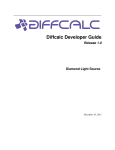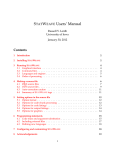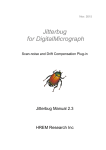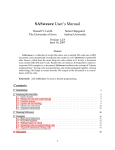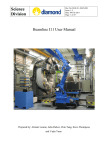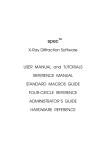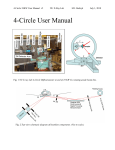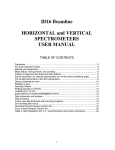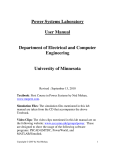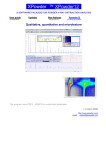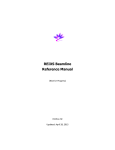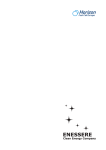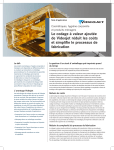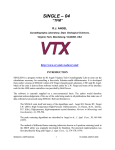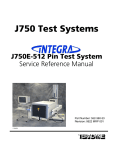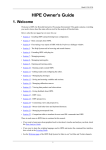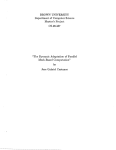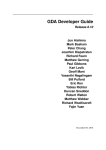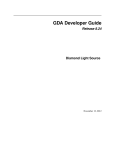Download Diffcalc Documentation Release 8.4 Rob Walton
Transcript
Diffcalc Documentation
Release 8.4
Rob Walton
April 21, 2010
CONTENTS
1
Introduction
3
2
Quick-start inside OpenGda
2.1 Install . . . . . . . . . . . . . . . . . . . . . . . . . . . . . . . . . . . . . . . . . . . . . . . . . . .
2.2 Start diffcalc . . . . . . . . . . . . . . . . . . . . . . . . . . . . . . . . . . . . . . . . . . . . . . .
5
5
5
3
Quick-Start outside OpenGDA
3.1 Setup environment . . . . . . . . . . . . . . . . . . . . . . . . . . . . . . . . . . . . . . . . . . . .
3.2 Start standalone . . . . . . . . . . . . . . . . . . . . . . . . . . . . . . . . . . . . . . . . . . . . .
3.3 Start with minigda . . . . . . . . . . . . . . . . . . . . . . . . . . . . . . . . . . . . . . . . . . . .
9
9
9
10
4
Diffcalc User Manual
4.1 Introduction . . . . .
4.2 Overview . . . . . . .
4.3 Getting Help . . . . .
4.4 Diffcalc’s Scannables
4.5 Crystal orientation . .
4.6 Moving in hkl space .
4.7 Scanning in hkl space
4.8 Thanks . . . . . . . .
13
13
14
15
16
17
22
26
27
.
.
.
.
.
.
.
.
.
.
.
.
.
.
.
.
.
.
.
.
.
.
.
.
.
.
.
.
.
.
.
.
.
.
.
.
.
.
.
.
.
.
.
.
.
.
.
.
.
.
.
.
.
.
.
.
.
.
.
.
.
.
.
.
.
.
.
.
.
.
.
.
.
.
.
.
.
.
.
.
.
.
.
.
.
.
.
.
.
.
.
.
.
.
.
.
.
.
.
.
.
.
.
.
.
.
.
.
.
.
.
.
.
.
.
.
.
.
.
.
.
.
.
.
.
.
.
.
.
.
.
.
.
.
.
.
.
.
.
.
.
.
.
.
.
.
.
.
.
.
.
.
.
.
.
.
.
.
.
.
.
.
.
.
.
.
.
.
.
.
.
.
.
.
.
.
.
.
.
.
.
.
.
.
.
.
.
.
.
.
.
.
.
.
.
.
.
.
.
.
.
.
.
.
.
.
.
.
.
.
.
.
.
.
.
.
.
.
.
.
.
.
.
.
.
.
.
.
.
.
.
.
.
.
.
.
.
.
.
.
.
.
.
.
.
.
.
.
.
.
.
.
.
.
.
.
.
.
.
.
.
.
.
.
.
.
.
.
.
.
.
.
.
.
.
.
.
.
.
.
.
.
.
.
.
.
.
.
.
.
.
.
.
.
.
.
.
.
.
.
.
.
.
.
.
.
.
.
.
.
.
.
.
.
.
.
.
.
.
.
.
.
.
.
.
.
.
.
.
.
.
.
.
.
.
.
5
Project Files & Directories
29
6
Indices and tables
31
i
ii
Diffcalc Documentation, Release 8.4
Contents:
CONTENTS
1
Diffcalc Documentation, Release 8.4
2
CONTENTS
CHAPTER
ONE
INTRODUCTION
Diffcalc is a diffraction condition calculator used for controlling diffractometers within reciprocal lattice space.
The core code will run by itself. However it makes more sense to use it within Diamond’s Gda framework which
provides motor control, a scan mechanism and more easily typed commands. An all-Python minimal framework,
minigda, that provides just the latter two of these features is provided within this distribution.
Diffcalc is written in Python. It will run under either Python 2.2 or greater with the numpy module, or under Jython
2.2 with Java’s Jama matrix package.
3
Diffcalc Documentation, Release 8.4
4
Chapter 1. Introduction
CHAPTER
TWO
QUICK-START INSIDE OPENGDA
2.1 Install
Copy the Diffcalc folder into the gda root folder (i.e. so it sits alongside plugins, thirdparty etc.)
2.2 Start diffcalc
Diffcalc is started from the command line or it can be started in localStation automatically. To start a dummy sixcircle
installation:
>>> diffcalc_path = gda.data.PathConstructor.createFromProperty("gda.root").split(’/plugins’)[0]
+ ’/diffcalc’
>>> execfile(diffcalc_path + ’/example/startup/sixcircle_dummy.py’)
/scratch/ws/8_4/diffcalc added to GDA Jython path.
================================================================================
Created DummyPD: alpha
Created DummyPD: delta
Created DummyPD: gamma
Created DummyPD: omega
Created DummyPD: chi
Created DummyPD: phi
Created diffractometer scannable: sixc
Created dummy energy scannable: en
Set dummy energy to 1 Angstrom
Created wavelength scannable: wl
Created hkl scannable: hkl
Created hkl component scannables: h, k & l
Created verbose hkl scannable: hklverbose. Reports virtual angles: 2theta, Bin, Bout, azimuth
Created parameter scannable: phi_par
Created parameter scannable: alpha_par
Created parameter scannable: oopgamma
Created parameter scannable: betaout
Created parameter scannable: azimuth
Created parameter scannable: betain
Created parameter scannable: blw
Aliased command: addref
Aliased command: autosector
Aliased command: calcub
Aliased command: checkub
Aliased command: dcversion
5
Diffcalc Documentation, Release 8.4
Aliased command: delref
Aliased command: editref
Aliased command: handleInputError
Aliased command: helphkl
Aliased command: helpub
Aliased command: hklmode
Aliased command: listub
Aliased command: loadub
Aliased command: mapper
Aliased command: newub
Aliased command: raiseExceptionsForAllErrors
Aliased command: saveubas
Aliased command: sector
Aliased command: setcut
Aliased command: setlat
Aliased command: setmax
Aliased command: setmin
Aliased command: setpar
Aliased command: setu
Aliased command: setub
Aliased command: showref
Aliased command: sigtau
Aliased command: sim
Aliased command: swapref
Aliased command: trackalpha
Aliased command: trackgamma
Aliased command: trackphi
Aliased command: transforma
Aliased command: transformb
Aliased command: transformc
Aliased command: ub
Aliased command: diffcalcdemo
================================================================================
Try the following:
newub ’cubic’
setlat ’cubic’ 1 1 1 90 90 90
pos wl 1
pos sixc [0 90 0 45 45 0]
addref 1 0 1
pos phi 90
addref 0 1 1
checkub
ub
hklmode
Or type ’diffcalcdemo’ to run this script (Caution, will move the diffractometer!)
================================================================================
Added objects/methods to namespace: gamma, trackalpha, phi, diffcalc_object, editref,
transformc, newub, setub, setpar, transforma, setu, off, autosector, dcversion, betaout,
sector, swapref, showref, setmin, trackgamma, ub, oopgamma, transformb, handleInputError,
l, listub, chi, manual, helpub, helphkl, azimuth, wl, setlat, sim, trackphi, alpha,
sigtau, omega, raiseExceptionsForAllErrors, saveubas, delref, hklmode, calcub, blw,
k, setcut, en, diffcalcdemo, sixc, hklverbose, addref, h, delta, betain, setmax, auto,
checkub, hkl, mapper, on, loadub, phi_par, alpha_par
Notice that this example script creates dummy scannables for the six axes and energy.
To use preexisting scannables modify:
6
Chapter 2. Quick-start inside OpenGda
Diffcalc Documentation, Release 8.4
diffcalcObjects = createDiffcalcObjects(
dummyAxisNames = (’alpha’, ’delta’, ’gamma’, ’omega’, ’chi’, ’phi’),
dummyEnergyName = ’en’,
geometryPlugin = ’sixc’,
hklverboseVirtualAnglesToReport=(’2theta’,’Bin’,’Bout’,’azimuth’),
demoCommands = demoCommands
)
to::
diffcalcObjects = createDiffcalcObjects(
axisScannableList = (alpha, delta, gamma, omega, chi, phi),
energyScannable = en,
geometryPlugin = ’sixc’,
hklverboseVirtualAnglesToReport=(’2theta’,’Bin’,’Bout’,’azimuth’),
demoCommands = demoCommands
)
Check out the user manual doc/user/manual.html . Also type diffcalcdemo to run the example session displayed above.
2.2. Start diffcalc
7
Diffcalc Documentation, Release 8.4
8
Chapter 2. Quick-start inside OpenGda
CHAPTER
THREE
QUICK-START OUTSIDE OPENGDA
This is for those who want to use Diffcalc outside the gda. It might also help with development.
3.1 Setup environment
Change directory to the diffcalc project:
$ cd diffcalc
$ ls
BUGS.txt
diffcalc
COPYING.txt docs
example
HISTORY.txt
# RELEASE-NOTES.txt
README.txt
test
THANKS.txt
If using Python make sure numpy and diffcalc can be imported:
$ PYTHONPATH=$PYTHONPATH:<diffcalc_root>
$ python
#use python2.4 at Diamond
Type "help", "copyright", "credits" or "license" for more information.
>>> import numpy
>>> import diffcalc
If using Jython make sure Jama and diffcalc can be imported:
$ jython -Dpython.path=<diffcalc_root>:<path_to_Jama>/Jama-1.0.1.jar
Jython 2.2.1 on java1.5.0_11
Type "copyright", "credits" or "license" for more information.
>>> import Jama
>>> import diffcalc
3.2 Start standalone
If you just want to try Diffcalc out as a user skip to the following section. To try out the code without using an external
framework use the sixcircle.py example startup script (notice the -i):
$ python2.4 -i example/startup/sixcircle.py
>>> mon
BaseHarwdareMonitor:
energy : 12.39842 keV
9
Diffcalc Documentation, Release 8.4
wavelength : 1.0 Angstrom
delta : 0.0 deg
gamma : 0.0 deg
omega : 0.0 deg
chi : 0.0 deg
phi : 0.0 deg
>>> dc.newub(’demo’)
>>> dc.setlat(’xtal’, 3.8401, 3.8401, 5.43072)
>>> mon.setWavelength(1.24)
>>> mon.setPosition((5.000, 22.790, 0.000, 1.552, 22.400, 14.255))
>>> dc.addref(1, 0, 1.0628)
>>> mon.setPosition((5.000, 22.790, 0.000, 4.575, 24.275, 101.320))
>>> dc.addref(0, 1, 1.0628)
Calculating UB matrix.
>>> dc.checkub()
energy h
k
l
1 9.9987 1.00 0.00 1.06
2 9.9987 0.00 1.00 1.06
h_comp k_comp l_comp tag
1.0000 0.0000 1.0628
-0.0329 1.0114 1.0400
>>> dc._hklToAngles(1,0,1.06) ((0.0, 23.281254709199715, 0.0,
11.640627354599907, 34.44739540990696, 3.21328587062226), {’Bin’:
6.5535895349220628, ’theta’: 70702.991919143591, ’Bout’:
6.5535895349220628, ’2theta’: 23.281254709199715, ’azimuth’:
4.6282344679186878})
>>> dc._anglesToHkl((0.0, 23.281254709199715, 0.0, 11.640627354599907,
34.44739540990696, 3.21328587062226)) ((0.99999999999999989,
-2.0078068981715935e-16, 1.0599999999999994), {’Bin’: 1234, ’theta’:
1234, ’Bout’: 1234, ’2theta’: 1234, ’azimuth’: 1234})
3.3 Start with minigda
The minigda framework in diffcalc/external/minigda provides a class Scannable of objects that can be
moved or read in a scan, a pos command for moving or reading their positions, a scan command and a translator for
mapping easy-to-type commands into method calls.
To install standalone or within the Minigda framework simply copy the projects directory somewhere handy. To install
into the gda copy (or link) the diffcalc package (it should contain an __init__.py file) from within the main diffcalc
project
To start the minigda:
$ python -t diffcalc/external/minigda/minigda.py
============================================================================
Starting minigda on linux2 at Fri Jan 30 15:52:12 2009 ...
============================================================================
sys.argv: [’diffcalc/external/minigda/minigda.py’]
============================================================================
WARNING: No startup script specified.
Starting minigda terminal. Type exit or press ctrl-d to return to Python
gda>>>pos
Typing pos would display the scannables positions if there were any. Press ctrl-d to exit the translator into regular
Python, and then term.start() to start again:
10
Chapter 3. Quick-Start outside OpenGDA
Diffcalc Documentation, Release 8.4
gda>>> pos
gda >>>dir()
Error: ’dir’ is not an aliased command, Scannable, or comment.
(Hint: unlike the gda system, the minigda does not currently
support regular Python syntax.)
gda>>> exit
>>> dir()
[’Pos’, ’STARTUPSCRIPT’, ’Scan’, ’ScanDataPrinter’,
’TerminalAliasedCommandsOnly’, ’__builtins__’, ’__doc__’,
’__file__’, ’__name__’, ’alias’, ’main’, ’os’, ’pos’, ’run’,
’scan’, ’sys’, ’term’, ’time’, ’usage’]
>>> term.start()
Starting minigda terminal. Type exit or press ctrl-d to return to Python
gda>>>
To tryout diffcalc within the minigda framework in earnest pass minigda
example/startup/sixcircle_with_scannables.py. With Jython for example:
the
argument
$ jython -Dpython.path=/path_to_workspace/diffcalc/:path_to_workspace/...
... gda_trunk_for_diffcalc/jars/Jama-1.0.1.jar...
... -i diffcalc/external/minigda/minigda.py example/startup/sixcircle_with_scannables.py
================================================================================
Starting minigda on java1.5.0_11 at Fri Feb 27 11:34:46 2009 ...
================================================================================
sys.version: 2.2.1
os.getcwd(): /home/zrb13439/synched/workspace/diffcalc
================================================================================
Running startup scipt ’example/startup/sixcircle_with_scannables.py’ ...
WARNING: ExampleSixCircleStartup.py is not running within the GDA: falling back to the (very minimal!
Starting minigda terminal. Type exit or press ctrl-d to return to Python
gda>>>pos
alpha:
0.0000
alpha_par:0.00000
azimuth: --betain:
--betaout: --chi:
0.0000
cnt:
0.0000
delta:
0.0000
en:
12.3984
gamma:
0.0000
gamma_par:0.00000
h:
Error: No UB matrix has been calculated during this ub calculation
hkl:
Error: No UB matrix has been calculated during this ub calculation
k:
Error: No UB matrix has been calculated during this ub calculation
l:
Error: No UB matrix has been calculated during this ub calculation
omega:
0.0000
phi:
0.0000
phi_par: --sixc:
alpha: 0.0000 delta: 0.0000 gamma: 0.0000 omega: 0.0000 chi: 0.0000 phi: 0.0000
wl:
1.0000
gda>>>
3.3. Start with minigda
11
Diffcalc Documentation, Release 8.4
12
Chapter 3. Quick-Start outside OpenGDA
CHAPTER
FOUR
DIFFCALC USER MANUAL
Diffraction Condition Calculator for Diffractometer Control
Author Rob Walton
Contact [email protected]
Web site http://opengda.org/
This file is written in reStructuredText and can be compiled into html, latex, xml or open-document-format using
Python’s Sphinx.
4.1 Introduction
This manual assumes that you are running Diffcalc within the external framework of the GDA or Minigda and that
Diffcalc has been configured for the six circle diffractometer pictured here:
Figure 4.1: Gamma-on-delta six-circle diffractometer, modified from Elias Vlieg & Martin Lohmeier (1993)
13
Diffcalc Documentation, Release 8.4
Your Diffcalc configuration will have been customised for the geometry of your diffractometer and possibly the types
of experiment you perform. For example: a five-circle diffractometer might be missing the Gamma circle above, some
six-circle modes and the option to fix gamma that would otherwise exist in some modes.
The laboratory, crystal and reciprocal-lattice coordinate frames are defined with respect to the beam and to gravity to
be (for a cubic crystal):
Figure 4.2: Laboratory and illustratrive crystal coordinate frames for a cubic crystal
The crystal lattice basis vectors are defined within the Cartesian crystal coordinate frame to be:
Figure 4.3: Unit cell defined in crystal coordinate frame
4.2 Overview
The following assumes that the diffractometer has been properly levelled, aligned with the beam and zeroed. See the
SPEC fourc manual.
Before moving in hkl space you must calculate a UB matrix by specifying the crystal’s lattice parameters (which
define the B matrix) and finding two reflections (from which the U matrix can be inferred); and, optionally for surfacediffraction experiments, determine how the surface of the crystal is oriented with respect to the phi axis.
Once a UB matrix has been calculated, the diffractometer may be driven in hkl coordinates. A valid diffractometer
setting maps easily into a single hkl value. However for a diffractometer with more than three circles there are excess
degrees of freedom when calculating a diffractometer setting from an hkl value. Diffcalc provides modes for using up
the excess degrees of freedom.
Diffcalc does not perform scans directly. Instead, scannables that use diffcalc to map between reciprocal lattice space
and real diffractometer settings are scanned using the Gda’s (or minigda’s) generic scan mechanism.
14
Chapter 4. Diffcalc User Manual
Diffcalc Documentation, Release 8.4
4.2.1 Theory
Thanks to Elias Vlieg for sharing his dos based DIF software that Diffcalc has borrowed heavily from. (See also the
THANKS.txt file).
See the papers (included in docs/ref):
• Busing & Levi (1966), “Angle Calculations for 3- and 4- Circle X-ray and Neutron Diffractometers”, Acta Cryst.
22, 457
• Elias Vlieg & Martin Lohmeier (1993), “Angle Calculations for a Six-Circle Surface X-ray Diffractometer”, J.
Appl. Cryst. 26, 706-716
4.3 Getting Help
There are few commands to remember. If a command is called without arguments, Diffcalc will prompt for arguments
and provide sensible defaults which can be chosen by pressing enter.
The helpub and helphkl commands provide help with the crystal orientation and hkl movement phases of an
experiment respectively:
>>> helpub
Diffcalc
-------helpub
helphkl
[’command’]
[’command’]
- lists all ub commands, or one if command is given
- lists all hkl commands, or one if command is given
UB State
-------newub
’name’
loadub
’name’
saveubas
’name’
- starts a new ub calculation with no lattice or
reflection list
- loads an existing ub calculation: lattice and
reflection list
- saves the ubcalculation with a new name (other
changes autosaved)
- shows the complete state of the ub calculation
ub
UB lattice
---------setlat
setlat
setlat
setlat
setlat
setlat
UB surface
---------sigtau
UB reflections
-------------showref
addref
addref
4.3. Getting Help
’name’
’name’
’name’
’name’
’name’
- prompts user to enter lattice parameters (in
Angstroms and Deg.)
a
- assumes cubic
a b
- assumes tetragonal
a b c
- assumes ortho
a b c gam
- assumes mon/hex with gam not equal to 90
a b c alpha beta gamma - arbitrary
[sigma tau]
- sets sigma and tau
h k l [’tag’]
- shows full reflection list
- add reflection
- add reflection with hardware position and energy
15
Diffcalc Documentation, Release 8.4
addref
delref
swapref
swapref
UB calculation
-------------setu
setub
calcub
checkub
h k l (p1,p2...pN) energy [’tag’]- add reflection with specified position
and energy
num
- deletes a reflection (numbered from 1)
- swaps first two reflections used for calculating U
num1 num2
- swaps two reflections (numbered from 1)
[((,,),(,,),(,,))] - manually set u matrix
((,,),(,,),(,,))
- manually set ub matrix
- (re)calculate u matrix from ref1 and ref2
- show calculated and entered hkl values for reflections
>>> helphkl
Diffcalc
-------helphkl
helpub
[command]
[command]
Settings
-------hklmode
[num]
setalpha
setgamma
setbetain
setbetaout
trackalpha
trackgamma
trackphi
setsectorlim
Motion
-----pos
sim
hkl
pos
sim
sixc
- lists all hkl commands, or one if command is given
- lists all ub commands, or one if command is given
- changes mode or shows current and available modes
and all settings
[num]
- fixes alpha, or shows all settings if no num given
[num]
- fixes gamma, or shows all settings if no num given
[num]
- fixes betain, or shows all settings if no num given
[num]
- fixes betaout, or shows all settings if no num given
[boolean]
- determines wether alpha parameter will track alpha axis
[boolean]
- determines wether gamma parameter will track gamma axis
[boolean]
- determines wether phi parameter will track phi axis
[omega_high omega_low phi_high phi_low]- sets sector limits
hkl [h k l]
- move diffractometer to hkl, or read hkl position.
Use None to hold a value still
hkl [h k l]
- simulates moving hkl
- shows loads of info about current hkl position
sixc [alpha, delta, gamma, omega, chi, phi,]- move diffractometer to Eularian
position. Use None to hold a
value still
sixc [alpha, delta, gamma, omega, chi, phi,]- simulates moving sixc
- shows loads of info about current sixc position
4.4 Diffcalc’s Scannables
Please see the neigbouring manual, docs/users/scannables_manual.txt, for an introduction to scannables, the pos command and scanning. Also refer to Moving in hkl space and Scanning in hkl space below for some relevant examples.
To list and show the current positions of your beamline’s scannables use pos with no arguments:
>>> pos
Results in:
16
Chapter 4. Diffcalc User Manual
Diffcalc Documentation, Release 8.4
Energy and wavelength scannables:
energy
wl:
12.3984
1.0000
Diffractometer scannables, as a group and in component axes (in the real GDA these have limits):
sixc:
alpha:
chi:
delta:
gamma:
omega:
phi:
alpha: 0.0000 delta: 0.0000 gamma: 0.0000 omega: 0.0000 chi: 0.0000 phi: 0.0000
0.0000
0.0000
0.0000
0.0000
0.0000
0.0000
Dummy counter, which in this example simply counts at 1hit/s:
cnt:
0.0000
Hkl scannable, as a group and in component:
hkl:
h:
k:
l:
Error:
Error:
Error:
Error:
No
No
No
No
UB
UB
UB
UB
matrix
matrix
matrix
matrix
Parameter scannables, used in some modes, these provide a scannable alternative to the series of fix commands
described in Moving in hkl space.:
alpha_par:0.00000
azimuth: --betain:
--betaout: --gamma_par:0.00000
phi_par: --Note that where a parameter corresponds with a physical
diffractometer axis, it can also be set to track that axis
directly. See ‘Tracking axis‘_ below.
4.5 Crystal orientation
Before moving in hkl space you must calculate a UB matrix by specifying the crystal’s lattice parameters (which
define the B matrix) and finding two reflections (from which the U matrix can be inferred); and, optionally for surfacediffraction experiments, determine how the surface of the crystal is oriented with respect to the phi axis (see Overview).
4.5.1 Starting a UB calculation
A UB-calculation contains the description of the crystal-under-test, any saved reflections, sigma & tau (both default to
0), and a B & UB matrix pair if they have been calculated or manually specified. Starting a new UB calculation will
clear all of these.
Before starting a UB-calculation, the ub command used to summarise the state of the current UB-calculation, will
reflect that no UB-calculation has been started:
4.5. Crystal orientation
17
Diffcalc Documentation, Release 8.4
>>> ub
No UB calculation started.
Wavelength: 1.239842
Energy: 10.000000
A new UB-calculation calculation may be started and lattice specified explicitly:
>>> newub ’b16_270608’
>>> setlat ’xtal’ 3.8401 3.8401 5.43072 90 90 90
or interactively:
>>> newub
calculation name: b16_270608
crystal name: xtal
a [1]: 3.8401
b [3.8401]: 3.8401
c [3.8401]: 5.43072
alpha [90]: 90
beta [90]: 90
gamma [90]: 90
where a,b and c are the lengths of the three unit cell basis vectors in Angstroms, and alpha, beta and gamma the
typically used angles (defined in the figure above) in Degrees.
The ub command will show the state of the current UB-calculation (and the current energy for reference):
UBCalc:
======
b16_270608
Crystal
------name:
xtal
lattice:
a ,b ,c
alpha, beta , gamma
= 3.84010, 3.84010, 5.43072
= 90.00000, 90.00000, 90.00000
reciprocal:
b1, b2, b3
beta1, beta2, beta3
=
=
B matrix:
1.6362035642769
0.0000000000000
0.0000000000000
Reflections
----------energy h
k
l
alpha
1.63620,
1.57080,
-0.0000000000000
1.6362035642769
0.0000000000000
delta
gamma
1.63620,
1.57080,
1.15697
1.57080
-0.000000000000
-0.000000000000
1.156970955450
omega
chi
phi
tag
UB matrix
--------none calculated
Sigma: 0.000000
Tau:
0.000000
Wavelength: 1.000000
Energy:
12.398420
18
Chapter 4. Diffcalc User Manual
Diffcalc Documentation, Release 8.4
4.5.2 Specifying Sigma and Tau for surface diffraction experiments
Sigma and Tau are used in modes that fix either the beam exit or entry angle with respect to the crystal surface, or that
keep the surface normal in the horizontal laboratory plane. For non surface-diffraction experiments these can safely
be left at zero.
For surface diffraction experiments, where not only the crystal’s lattice planes must be oriented appropriately but so
must the crystal’s optical surface, two angles _Tau_ and _Sigma_ define the orientation of the surface with respect to
the phi axis. Sigma is (minus) the amount of chi axis rotation and Tau (minus) the amount of phi axis rotation needed
to move the surface normal parallel to the omega circle axis. These angles are often determined by reflecting a laser
from the surface of the Crystal onto some thing and moving chi and tau until the reflected spot remains stationary with
movements of omega.
Use sigtau with no args to set interactively:
>>> pos chi -3.1
chi:
-3.1000
>>> pos phi 10.0
phi:
10.0000
>>> sigtau
sigma, tau = 0.000000, 0.000000
chi, phi = -3.100000, 10.000000
sigma[ 3.1]: 3.1
tau[-10.0]: 10.0
Sigma and Tau can also be set explicitly:
>>>sigtau 0 0
4.5.3 Managing reflections
The normal way to calculate a UB matrix is to find the position of two reflections with known hkl values. Diffcalc
allows many reflections to be recorded but currently only uses the first two when calculating a UB matrix.
Add reflection at current location
It is normal to first move to a reflection:
>>> pos en 10
en:
10.0000
>>> pos sixc [5.000, 22.790, 0.000, 1.552, 22.400, 14.255]
sixc:
alpha: 5.0000 delta: 22.7900 gamma: 0.0000 omega: 1.5520 chi: 22.4000 phi: 14.2550
and then use the addref command either explicitly:
addref
1 0 1.0628 ’optional_tag’
or interactively:
>>> addref
h: 1
k: 0
l: 1.0628
4.5. Crystal orientation
19
Diffcalc Documentation, Release 8.4
current pos[y]: y
tag: ’tag_string’
to add a reflection.
Add a reflection manually
If a reflection cannot be reached but its position is known (or if its position has been previously determined), a reflection
may be added without first moving to it either explicitly:
>>> addref 0 1 1.0628 [5.000, 22.790, 0.000,4.575, 24.275, 101.320] ’optional_tag’
or interactively:
>>> addref
h: 0
k: 1
l: 1.0628
current pos[y]: n
alpha[5.000]:
delta[22.79]:
gamma[0.000]:
omega[1.552]: 4.575
chi[22.40]: 24.275
phi[14.25]: 101.320
en[9.998]:
tag: optional_tag2
Edit reflection list
Use showref to show the reflection list:
>>> showref
energy h
k
l
1 9.999 1.00 0.00 1.06
2 9.999 0.00 1.00 1.06
alpha
5.0000
5.0000
delta
22.7900
22.7900
gamma
0.0000
0.0000
omega
1.5520
4.5750
chi
22.4000
24.2750
phi
tag
14.2550
1st
101.32000 2nd
Use swapref to swap reflections:
>>> swapref 1 2
Recalculating UB matrix.
>>> showref
energy h
k
l
1 9.999 0.00 1.00 1.06
2 9.999 1.00 0.00 1.06
alpha
5.0000
5.0000
delta
22.7900
22.7900
gamma
0.0000
0.0000
omega
4.5750
1.5520
chi
24.2750
22.4000
phi
101.3200
14.2550
tag
2nd
1st
alpha
5.0000
delta
22.7900
gamma
0.0000
omega
1.5520
chi
22.4000
phi
14.2550
tag
1st
Use delref to delete a reflection:
>>> delref 1
>>> showref
energy h
k
l
1 9.999 1.00 0.00 1.06
20
Chapter 4. Diffcalc User Manual
Diffcalc Documentation, Release 8.4
4.5.4 Calculating a UB matrix
Unless a U or UB matrix has been manually specified, a new UB matrix will be calculated after the second reflection
has been found, or whenever one of the first two reflections is changed.
Use the command calcub to force the UB matrix to be calculated from the first two reflections.
If you have misidentified a reflection used for the orientation the resulting UB matrix will be incorrect. Always use
the checkub command to check that the computed values agree with the estimated values:
>>>checkub
energy h
k
l
h_comp k_comp l_comp
1 9.9987 1.00 0.00 1.06 1.0000 0.0000 1.0628
2 9.9987 0.00 1.00 1.06 -0.0329 1.0114 1.0400
tag
1st
2nd
Notice that the first reflection will always match, but that the second will not match exactly. (The system of equations
used to calculate the U matrix is overdetermined and some information from the second reflection is thrown away.)
4.5.5 Manually setting U and UB
To help find the initial reflections it may be useful to set the U matrix manually—to the identity matrix for example.
Use the setu command to do this. Once set the diffractometer may be driven to the ideal location of a reflection and
then the actual reflection sought. Normally this would be done in the default mode, four-circle-bisecting, (see Moving
in hkl space ). In the following example this has been done by setting the alpha to 5 and leaving gamma at 0 (it would
be normal to leave alpha at 0):
>>> hklmode 1
1) fourc bisecting
alpha: 0.0
gamma: 0.0
>>> setalpha 5
alpha: 0 --> 5.000000
>>> setu
row1[1 0 0]:
row2[0 1 0]:
row3[0 0 1]:
>>> sim hkl [1,0,1.0628] # Check it all makes sense
sixc would move to:
alpha :
5.00000 deg
delta : 22.79026 deg
gamma :
0.00000 deg
omega :
5.82845 deg
chi : 24.57658 deg
phi :
6.14137 deg
theta
2theta
Bin
Bout
azimuth
:
:
:
:
:
70702.991919
23.303705
6.969151
6.969151
7.262472
>>> pos hkl [1,0,1.0628]
hkl:
h: 1.00000 k: 0.00000 l: 1.06280
>>> # scan about to find actual reflection
4.5. Crystal orientation
21
Diffcalc Documentation, Release 8.4
>>> addref
h[0.0]: 1
k[0.0]: 0
l[0.0]: 1.0628
current pos[y]: y
tag: ’ref1’
>>>
There is currently no way to refine a manually specified U matrix by inferring as much as possible from just one found
reflection.
4.6 Moving in hkl space
Once a UB matrix has been calculated, the diffractometer may be driven in hkl coordinates. A given diffractometer
setting maps easily into a single hkl value. However for a diffractometer with more than three circles there are excess
degrees of freedom when calculating a diffractometer setting from an hkl value. Diffcalc provides many for using up
the excess degrees of freedom.
By default Diffcalc selects four-circle bisecting mode (see below).
Note that to play along with the following run the file in example/session/sixc_example.py to configure
the UB-calculation.
4.6.1 Modes
Use the command hklmode to summarise the state of Diffcalc’s angle calculator. It shows a list the available modes
for your diffractometer and the parameters that must be fixed for each, the current mode and the current parameter
settings:
>>> hklmode
Available modes:
0) fourc fixed-bandlw (alpha, gamma, blw) (Not impl.)
1) fourc bisecting (alpha, gamma)
2) fourc incoming (alpha, gamma, betain)
3) fourc outgoing (alpha, gamma, betaout)
4) fourc azimuth
(alpha, gamma, azimuth) (Not impl.)
5) fourc fixed-phi (alpha, gamma, phi) (Not impl.)
10) fivec bisecting (gamma)
11) fivec incoming (gamma, betain)
12) fivec outgoing (gamma, betaout)
13) fivec bisecting (alpha)
14) fivec incoming (alpha, betain)
15) fivec outgoing (alpha, betaout)
20) zaxis bisecting ()
21) zaxis incoming (betain)
22) zaxiz outgoing (betaout)
Current mode:
1) fourc bisecting
Parameters:
alpha: 0.0
gamma: 0.0
22
Chapter 4. Diffcalc User Manual
Diffcalc Documentation, Release 8.4
betain:
betaout:
azimuth:
phi:
blw:
-----------
(not
(not
(not
(not
(not
relevant
relevant
relevant
relevant
relevant
in
in
in
in
in
this
this
this
this
this
mode)
mode)
mode)
mode)
mode)
Note that ‘Not impl.’ is short for ‘not implemented’. Standby.
Your output may differ. For example:
• When listed with a typical five-circle diffractometer with no gamma circle: the fourc modes will have no gamma
parameter to fix (actually it will have been fixed under the covers to 0), there will be no gamma or alpha
parameters to fix in the five circle modes (again, under the covers gamma will have been fixed) and there will
be no zaxis modes (as these require six circles, or an actual z-axis diffractometer).
• When listed with a typical four-circle diffractometer with no alpha or gamma circle, the four-circle modes will
appear with no alpha or gamma parameters (again, they are fixed under the covers), and there will be no five
circle or zaxis modes.
To change the current mode, call hklmode with an argument:
>>> hklmode 2
2) fourc incoming
alpha: 0.0
gamma: 0.0
betain: ---
(The dashes next to the betain parameter indicate that a parameter has not yet been set.)
4.6.2 Mode parameters
A parameter can be set using either one of the series of {{{set}}} commands, by moving one of the scannables
associated with each parameter or, where appropriate, by asking that a parameter track an axis.
Set commands
Use the series of commands set<param_name> to set a parameter:
>>> setalpha 3
alpha: 0 --> 3.000000
>>> setbetain 5
WARNING: The parameter betain is not used in mode 1
betain: --- --> 5.000000
>>> setalpha
# With no args, the current value is displayed
alpha: 3
>>> setbetain
betain: ---
Parameter Scannables
In most installations there will be a scannable for each parameter. In this example installation, the parameters which
correspond to physical axes have had ‘_par’ appended to their names to prevent clashes. These may be used to change
a parameter either with the pos command or by using them within a scan (see Scanning in hkl space).:
4.6. Moving in hkl space
23
Diffcalc Documentation, Release 8.4
>>> pos betain
betain:
0.00000
>>> pos betain 5
betain:
5.00000
>>> setbetain
betain: 5
>>> pos alpha_par
alpha_par:3.00000
>>> setalpha
alpha: 3
Tracking Axis
Where a parameter matches an axis name, that parameter may be set to track that axis:
>>> pos alpha
alpha:
5.0000
>>> hklmode 1
1) fourc bisecting
alpha: 0.0
gamma: 0.0
>>> trackalpha
alpha: 5
>>> pos alpha
alpha:
6.0000
>>> hklmode 1
1) fourc bisecting
alpha: 6.0 (tracking physical axis)
gamma: 0.0
Although convenient, there is a danger with this method that in geometries where the axes are built from other axes
(such as in a kappa geometry), the position of an axis may drift slightly during a scan.
4.6.3 Sectors
When mapping from reciprocal lattice space to a set of diffractometer settings, there is normally a choice of solutions
for the sample orientation. The selected sector mode will determine which solution is used. There is currently only
one sector mode:
Sector mode: Find first solution within sector limits
In this sector mode, taken from ‘DIF’, the first solution found within the ‘sector limits’ is chosen. These are different
from the physical or software limits on the axes and can be checked/modified using setsectorlim:
>>> setsectorlim
omega_high[270]:
omega_low[-90]:
24
Chapter 4. Diffcalc User Manual
Diffcalc Documentation, Release 8.4
phi_high[180]:
phi_low[-180]:
4.6.4 The hkl scannable
Once a UB matrix has been calculated, a mode chosen and parmeters set, use the hkl scannable to move to a point in
reciprocal lattice space:
>>> pos hkl [1,0,0]
hkl:
h: 1.00000 k: -0.00000 l: -0.00000
>>> pos sixc
sixc:
alpha: 3.0000 delta: 17.2252 gamma: 4.0000 omega: 7.5046 chi: -24.6257 phi: 4.8026
>>> pos hkl
hkl:
h: 1.00000 k: -0.00000 l: -0.00000
>>> hkl
hkl:
h : 1.000000
k : -0.000000
l : -0.000000
2theta : 18.582618
Bin : -0.387976
Bout : -0.387976
azimuth : 1.646099
Notice that typing hkl will also display some virtual angles (such as twotheta and Bin), that checking the position
with pos hkl will not.
To get this extra information into a scan use the scannable hklverbose instead of hkl:
>>> pos hklverbose [1,0,0]
hklverbose:
h: 1.00000 k: -0.00000 l: -0.00000 2theta : 18.582618 Bin : -0.387976
Bout :-0.387976 azimuth : 1.646099
The sim command will report, without moving the diffractometer, where an hkl position would be found:
>>> sim hkl [1,0,0]
sixc would move to:
alpha :
3.00000
delta : 17.22516
gamma :
4.00000
omega :
7.50461
chi : -24.62568
phi :
4.80260
theta
2theta
Bin
Bout
azimuth
:
:
:
:
:
deg
deg
deg
deg
deg
deg
70702.991919
18.582618
-0.387976
-0.387976
1.646099
Moving out of range
Not every hkl position can be reached:
4.6. Moving in hkl space
25
Diffcalc Documentation, Release 8.4
>>> pos hkl [10,10,10]
Exception: Could not compute delta for this hkl position
4.6.5 The diffractometer scannable (sixc)
We’ve seen this before, but it also works with sim:
gda>>>sim sixc [3, 17.22516, 4, 7.50461,
hkl would move to:
h : 1.000000
k : 0.000000
l : -0.000000
-24.62568, 4.80260]
4.7 Scanning in hkl space
All scans described below use the same generic scanning mechanism provided by the GDA system or by minigda.
Here are some examples.
4.7.1 Fixed hkl scans
In a ‘fixed hkl scan’ something (such as energy or Bin) is scanned, and at each step hkl is ‘moved’ to keep the sample
and detector aligned. Also plonk the diffractometer scannable (sixc) on there with no destination to monitor what is
actually happening and then throw on a detector (cnt) with an exposure time if appropriate:
>>> #scan scannable_name start stop step [scannable_name [pos or time]]..
>>> scan en 9 11 .5 hkl [1,0,0] sixc cnt 1
>>> scan en 9 11 .5 hklverbose [1,0,0] sixc cnt 1
>>> scan betain 4 5 .2 hkl [1,0,0] sixc cnt 1
>>> scan alpha_par 0 10 2 hkl [1,0,0] sixc cnt 1
>>> trackalpha
>>> scan alpha 0 10 2 hkl [1,0,0] sixc cnt 1 # Equivalent to last scan
4.7.2 Scanning hkl
Hkl, or one component, may also be scanned directly:
>>> scan h .8 1.2 .1 hklverbose sixc cnt 1
At each step, this will read the current hkl position, modify the h component and then move to the resulting vector.
There is a danger that with this method k and l may drift. To get around this the start, stop and step values may also be
specified as vectors. So for example:
>>> scan hkl [1,0,0] [1,.3,0] [1,0.1,0] cnt1
26
Chapter 4. Diffcalc User Manual
Diffcalc Documentation, Release 8.4
is equivilant to:
>>> pos hkl [1,0,0]
>>> scan k 0 .3 .1 cnt1
but will not suffer from drifting. This method also allows scans along any direction in hkl space to be performed.
4.7.3 Multidimension scans
Two and three dimensional scans:
>>> scan en 9 11 .5 h .9 1.1 .2 hklverbose sixc cnt 1
>>> scan h 1 3 1 k 1 3 1 l 1 3 1 hkl cnt 1
Good luck — RobW
4.8 Thanks
I would like to acknowledge the people who have made a direct impact on the Diffcalc project, knowingly or not, in
terms of encouragement, suggestions, criticism, bug reports, code contributions, and related projects:
• Elias Vlieg — writer of DIF software used as a model for Diffcalc
• Spec
• Diamond
• Chris Nicklin
• Allesandro Bombardi
• Steve Collins
• Martin Lohmier And Elias Vlieg
• Busang & Levi
Thank you!
4.8. Thanks
27
Diffcalc Documentation, Release 8.4
28
Chapter 4. Diffcalc User Manual
CHAPTER
FIVE
PROJECT FILES & DIRECTORIES
diffcalc The project source directory, installed as a Python package.
docs This project documentation directory. The documentation is written in reStructuredText and can be compiled
into html and pdf using Python’s Sphinx.
docs/ref Includes pdfs of relevant papers.
tests Unit tests. Not required to use the software, but very useful if you’re planning to modify it.
example Example startup scripts.
models Vrml models of diffractometers (not tied into diffcalc or OpenGda yet).
29
Diffcalc Documentation, Release 8.4
30
Chapter 5. Project Files & Directories
CHAPTER
SIX
INDICES AND TABLES
• Index
• Module Index
• Search Page
31



































